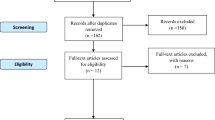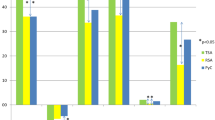Abstract
Background
Pyrocarbon (PyC) interposition shoulder arthroplasty can be used to treat advanced collapse of the humeral head after avascular necrosis.
Objectives
We examined outcomes for this bone-preserving implant which has a PyC coating and a novel biomechanical concept.
Materials and methods
For a minimum of 2 years, we followed 10 patients (4 men, 6 women, 55.6 ± 12.9 years) treated with a free interposition PyC arthroplasty (“snookerball”) due to advanced humeral head collapse but with an intact glenoid and rotator cuff. Anteroposterior radiographs, the Constant score (CS), adjusted CS, DASH score, and the EuroQol 5D–5L score from the preoperative and the latest follow-up presentation were compared.
Results
At a mean of 3.6 years (±15 months), the mean absolute CS was 70.6 (±13.6; adjusted CS 81.4 ± 16.4), the DASH score was 25.6 (±16.1), the mean EQ subjective VAS score was 72.6 (±15.9), and the EQ index score was 0.9 (±0.11). Scores improved: CS: +63.2 ± 12.9; adjusted CS: +72.9 ± 15.5; DASH: +47.2 ± 14.7; EQ VAS: +42.6 ± 16.8; EQ index score +0.52 ± 0.23. Mean glenoid erosion was 1.4 mm (±1.3 mm), thinning of the tuberosities was −0.8 mm (±3.3 mm), and superior migration of the implant was 2.0 mm (±2.2). A thin radiolucent zone around the implant with bone densification on the metaphyseal side was observed in all cases (mean 1.8 ± 0.6 mm).
Conclusions
Excellent improvement of function and quality of life which are comparable to total shoulder arthroplasty data were observed. Significant bone remodeling occurs in the metaphysis around the implant. Further studies are needed to evaluate longevity and applicability of the implant. These results indicate that advanced collapse of the humeral head with an intact glenoid and rotator cuff are an optimal indication for this implant.
Zusammenfassung
Hintergrund
Eine Interpositions-Hemiprothese aus Pyrocarbon (PyC) ist eine Option zur Behandlung der ausgeprägten avaskulären Humeruskopfnekrose.
Fragestellung
Die Ergebnisse dieses knochensparenden Implantats mit neuartiger Biomechanik wurden ermittelt.
Material und Methoden
Zehn Patienten (4 m., 6 w., Alter: 55,6 ± 12,9 Jahre) wurden wegen fortgeschrittener Humeruskopfnekrose mit pyrocarbonbeschichteter Interpositions-Hemiprothese („Snookerball“) behandelt und mindestens 2 Jahre postoperativ beobachtet. Glenoid und Rotatorenmanschette waren intakt. a.-p.-Röntgenbilder, Constant Score (CS), angepasster CS, DASH und EuroQol 5D–5 L (EQ) aus präoperativer und aktuellster Kontrolluntersuchung wurden verglichen.
Ergebnisse
Nach durchschnittlich 3,6 Jahren (±15 Monate) postoperativ lag der absolute CS im Durchschnitt bei 70,6 (±13,6), der angepasste CS bei 81,4 (±16,4). Der DASH lag bei 25,6 (±16,1), der EQ VAS bei 72,6 (±15,9) und der EQ-Index bei 0,9 (±0,11). Die Werte verbesserten sich: CS: +63,2 ± 12,9; angepasster CS: +72,9 ± 15,5; DASH: +47,2 ± 14,7; EQ VAS: +42,6 ± 16,8; EQ-Index: +0,52 ± 0,23. Die Glenoiderosion erreichte im Durchschnitt 1,4 mm (±1,3 mm), die knöcherne Substanz der Tubercula verschmälerte sich um −0,8 mm (±3,3 mm), und das Implantat verschob sich um 2,0 mm (±2,2) nach kranial. Eine schmale, röntgentransparente Zone mit metaphysärem Sklerosierungssaum bildete sich bei allen rund um das Implantat aus (1,8 mm, ±0,6 mm).
Schlussfolgerung
Funktion und Lebensqualität verbesserten sich ausgezeichnet und waren vergleichbar mit den Ergebnissen nach Totalendoprothese. Knöcherne Umbauprozesse traten in der Metaphyse rund um das Implantat auf. Weitere Studien sind nötig, um die Langlebigkeit und Anwendbarkeit des Implantats zu ermitteln. Den bisherigen Ergebnissen zufolge ist die fortgeschrittene Humeruskopfnekrose bei erhaltenem Glenoid und intakter Rotatorenmanschette eine optimale Indikation für das neuartige Implantat.







Similar content being viewed by others
Abbreviations
- AP:
-
Anteroposterior
- AVN:
-
Avascular humeral head necrosis
- CS:
-
Constant score
- DASH:
-
Disabilities of Arm, Shoulder, and Hand
- EQ:
-
EuroQol EQ 5D–5L
- FU:
-
Follow-up
- HA:
-
Hemiarthroplasty
- LOA:
-
Limits of agreement
- MALDI-TOF:
-
Matrix-assisted laser desorption/ionization time of flight
- MRI:
-
Magnetic resonance imaging
- PyC:
-
Pyrocarbon
- ROM:
-
Range of motion
- SD:
-
Standard deviation
- TSA:
-
Total shoulder arthroplasty
- VAS:
-
Visual analog scale
References
Barlow JD, Abboud J (2016) Surgical options for the young patient with glenohumeral arthritis. Int J Shoulder Surg 10:28–36
Bhatia S, Hsu A, Lin EC et al (2012) Surgical treatment options for the young and active middle-aged patient with glenohumeral arthritis. Adv Orthop 2012:846843
Bland JM, Altman DG (1986) Statistical methods for assessing agreement between two methods of clinical measurement. Lancet 1:307–310
Bokros JC (1989) Carbon in prosthetic heart valves. Ann Thorac Surg 48:S49–S50
Campochiaro G, Rebuzzi M, Baudi P et al (2015) Complex proximal humerus fractures: Hertel’s criteria reliability to predict head necrosis. Musculoskelet Surg 99(Suppl 1):S9–S15
Carter MJ, Mikuls TR, Nayak S et al (2012) Impact of total shoulder arthroplasty on generic and shoulder-specific health-related quality-of-life measures: a systematic literature review and meta-analysis. J Bone Joint Surg Am 94:e127
Cook SD, Klawitter JJ, Weinstein AM (1981) The influence of implant elastic modulus on the stress distribution around LTI carbon and aluminum oxide dental implants. J Biomed Mater Res 15:879–887
Cook SD, Thomas KA, Kester MA (1989) Wear characteristics of the canine acetabulum against different femoral prostheses. J Bone Joint Surg Br 71:189–197
Denard PJ, Wirth MA, Orfaly RM (2011) Management of glenohumeral arthritis in the young adult. J Bone Joint Surg Am 93:885–892
Fuchs B, Weishaupt D, Zanetti M et al (1999) Fatty degeneration of the muscles of the rotator cuff: assessment by computed tomography versus magnetic resonance imaging. J Shoulder Elbow Surg 8:599–605
Garret J, Godeneche A, Boileau P et al (2017) Pyrocarbon interposition shoulder arthroplasty: preliminary results from a prospective multicenter study at 2 years of follow-up. J Shoulder Elbow Surg 26:1143–1151
Gauci MO, Winter M, Dumontier C et al (2016) Clinical and radiologic outcomes of pyrocarbon radial head prosthesis: midterm results. J Shoulder Elbow Surg 25:98–104
Gras M, Wahegaonkar AL, Mathoulin C (2012) Treatment of avascular necrosis of the proximal pole of the scaphoid by arthroscopic resection and prosthetic semireplacement arthroplasty using the pyrocarbon Adaptive Proximal Scaphoid Implant (APSI): long-term functional outcomes. J Wrist Surg 1:159–164
Hassler M (2015) Pyrocarbon properties. In: Hudek DR (ed) Tornier SAS, Montbonnot Saint Martin, p 7
Hussey MM, Steen BM, Cusick MC et al (2015) The effects of glenoid wear patterns on patients with osteoarthritis in total shoulder arthroplasty: an assessment of outcomes and value. J Shoulder Elbow Surg 24:682–690
Katolik LI, Romeo AA, Cole BJ et al (2005) Normalization of the constant score. J Shoulder Elbow Surg 14:279–285
Levine WN, Fischer CR, Nguyen D et al (2012) Long-term follow-up of shoulder hemiarthroplasty for glenohumeral osteoarthritis. J Bone Joint Surg Am 94:e164
Matsen FA 3rd, Clinton J, Lynch J et al (2008) Glenoid component failure in total shoulder arthroplasty. J Bone Joint Surg Am 90:885–896
Mcguire DT, White CD, Carter SL et al (2012) Pyrocarbon proximal interphalangeal joint arthroplasty: outcomes of a cohort study. J Hand Surg Eur Vol 37:490–496
Nagels J, Valstar ER, Stokdijk M et al (2002) Patterns of loosening of the glenoid component. J Bone Joint Surg Br 84:83–87
Nagels J, Stokdijk M, Rozing PM (2003) Stress shielding and bone resorption in shoulder arthroplasty. J Shoulder Elbow Surg 12:35–39
Ouenzerfi GHM, Trunflo-Sfarghiu A, Nallet a, Berthier Y (2015) Triboligical behavior of pyrolytic carbon against bone promotes cartilage regeneration? Proceedings of the 42nd Leeds-Lyon Symposium on Tribology 2015, Lyon.
Papadonikolakis A, Neradilek MB, Matsen FA 3rd (2013) Failure of the glenoid component in anatomic total shoulder arthroplasty: a systematic review of the English-language literature between 2006 and 2012. J Bone Joint Surg Am 95:2205–2212
Pettersson K, Amilon A, Rizzo M (2015) Pyrolytic carbon hemiarthroplasty in the management of proximal interphalangeal joint arthritis. J Hand Surg Am 40:462–468
Sandow MJ, David H, Bentall SJ (2013) Hemiarthroplasty vs total shoulder replacement for rotator cuff intact osteoarthritis: how do they fare after a decade? J Shoulder Elbow Surg 22:877–885
Author information
Authors and Affiliations
Corresponding author
Ethics declarations
Conflict of interest
R. Hudek, B. Werner, A. Abdelkawi and F. Gohlke declare that they have no competing interests.
Ethical committee approval: Given by the Freiburger Ethik-Kommission, Feki Code: 014/1483. Written consent was given by each patient prior to surgery. The manuscript has been read and approved by all authors, and all authors believe that the manuscript presents honest work.
Rights and permissions
About this article
Cite this article
Hudek, R., Werner, B., Abdelkawi, A. et al. Pyrocarbon interposition shoulder arthroplasty in advanced collapse of the humeral head. Orthopäde 46, 1034–1044 (2017). https://doi.org/10.1007/s00132-017-3495-2
Published:
Issue Date:
DOI: https://doi.org/10.1007/s00132-017-3495-2




